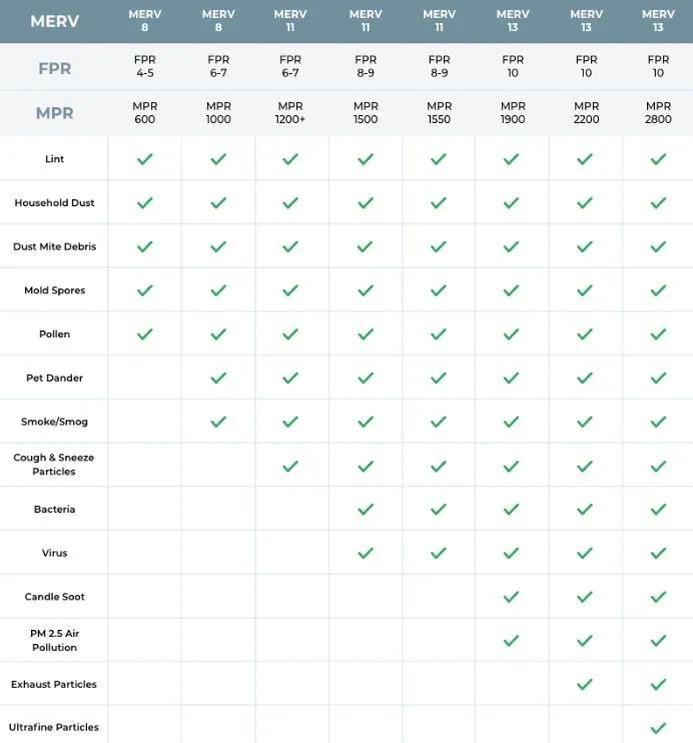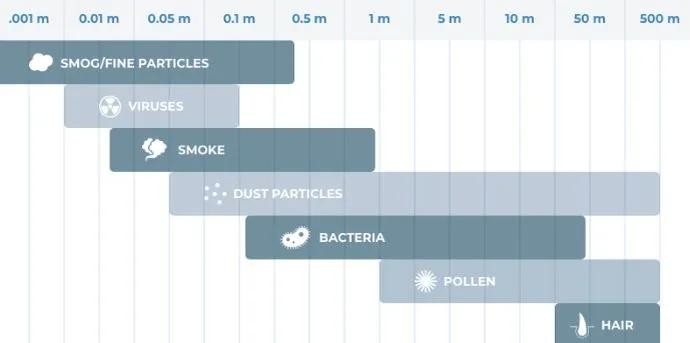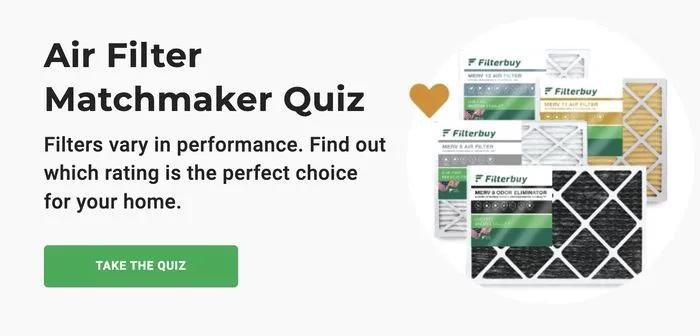How Does Fpr Compare To Merv ratings when selecting air filters? FPR, developed by Home Depot, and MERV, an industry standard, both rate air filter efficiency, but understanding their differences is essential for optimal air quality. COMPARE.EDU.VN simplifies these comparisons, providing detailed insights to help you choose the best air filter for your needs. Explore our comprehensive guides on air purification and filtration systems to make an informed decision.
1. Understanding Air Filter Ratings: MERV, FPR, and MPR
Navigating the world of air filters can be complex, with various rating systems like MERV (Minimum Efficiency Reporting Value), FPR (Filter Performance Rating), and MPR (Microparticle Performance Rating) used to indicate their effectiveness. Each rating system helps consumers understand how well a filter captures airborne particles, contributing to better indoor air quality.
1.1. What is MERV (Minimum Efficiency Reporting Value)?
MERV, or Minimum Efficiency Reporting Value, is a standard rating system developed by ASHRAE (American Society of Heating, Refrigerating and Air-Conditioning Engineers) used to measure the efficiency of air filters. The MERV rating indicates a filter’s ability to capture larger particles, such as dust, pollen, and pet dander, and ranges from 1 to 16. A higher MERV rating signifies better filtration, making it a reliable benchmark for filter performance in both residential and commercial settings.
1.2. What is FPR (Filter Performance Rating)?
FPR, or Filter Performance Rating, is a proprietary rating system developed by The Home Depot for the air filters sold in its stores, including popular brands like Honeywell. The FPR scale ranges from 4 to 10, aligning closely with the MERV scale but tailored for Home Depot’s retail environment. FPR simplifies the buying process for consumers by categorizing filters based on their ability to capture particles, making it easier to choose a filter based on simplified categories.
1.3. What is MPR (Microparticle Performance Rating)?
MPR, or Microparticle Performance Rating, is a proprietary rating system created by 3M. This rating emphasizes a filter’s ability to capture fine particles that are harmful to health, such as smoke, smog, and microscopic allergens. The MPR scale ranges from 300 to 2800, specifically measuring filtration efficiency for particles smaller than 1 micron. MPR is particularly useful for residential settings where fine particle filtration is critical, such as homes with allergy sufferers or areas with high pollution levels.
2. Key Differences Between FPR and MERV Ratings
While both FPR and MERV ratings aim to help consumers choose effective air filters, they differ in their origin, scale, and application. Understanding these differences is crucial when deciding which rating system to follow.
2.1. Origin and Scale
- MERV: Developed by ASHRAE, the standard measurement in the air filtration industry. It uses a scale of 1-16, with higher ratings indicating better filtration capabilities for a broader range of particles.
- FPR: Developed by The Home Depot for the brands sold in its stores. It uses a scale of 4-10, aligning closely with the MERV scale but tailored for Home Depot’s retail environment.
2.2. Application and Use
- MERV: Ideal for general use where a balance between air quality and system efficiency is needed. It’s recognized industry-wide and offers a reliable benchmark for filter performance.
- FPR: Offers a straightforward rating system for consumers shopping at Home Depot, making it easy to choose a filter based on simplified categories.
2.3. Advantages and Disadvantages
| Feature | MERV | FPR |
|---|---|---|
| Origin | ASHRAE | The Home Depot |
| Scale | 1-16 | 4-10 |
| Application | General use, recognized industry-wide | Simplified buying process for Home Depot customers |
| Advantage | Reliable benchmark for filter performance | User-friendly approach to choosing filters |
| Disadvantage | Can be overwhelming for consumers due to the broad scale | Limited availability to Home Depot stores and their branded filters |



3. Comparing FPR to MERV: A Detailed Conversion Guide
To effectively compare FPR and MERV ratings, it’s helpful to understand how they correlate. This conversion guide provides a clear comparison, allowing consumers to make informed decisions regardless of the rating system used.
3.1. FPR vs. MERV Conversion Chart
| FPR Rating | Equivalent MERV Rating(s) |
|---|---|
| 4-5 | 6-8 |
| 6-7 | 8-11 |
| 8-9 | 11 |
| 10 | 13 |
3.2. Understanding the Equivalencies
- FPR 4-5: Equivalent to MERV 6-8, these filters are suitable for capturing common air pollutants such as dust mites, pollen, and pet dander.
- FPR 6-7: Equivalent to MERV 8-11, these filters offer enhanced filtration for environments with pets, smokers, or people with mild allergies.
- FPR 8-9: Equivalent to MERV 11, these filters excel at catching finer particles, improving air purity and freshness.
- FPR 10: Equivalent to MERV 13, these filters are ideal for demanding air quality needs, removing over 90% of airborne particles, including fine dust, bacteria, and smoke.
4. How to Choose the Right Air Filter Based on Your Needs
Selecting the right air filter involves considering your specific air quality needs, the presence of allergens or pollutants, and the compatibility of the filter with your HVAC system.
4.1. Assessing Your Air Quality Needs
- Identify Allergens and Pollutants: Determine if you need to filter out common allergens like pollen and pet dander or finer particles like smoke and smog.
- Consider Health Conditions: If you or your family members have allergies, asthma, or other respiratory issues, opt for filters with higher ratings.
- Evaluate Your Environment: If you live in an area with high pollution levels or near construction sites, choose filters that offer superior filtration.
4.2. Matching Filters to Specific Scenarios
- General Residential Use: MERV 8 or FPR 4-5 filters are suitable for everyday use, capturing common air pollutants without overburdening your HVAC system.
- Homes with Pets or Smokers: MERV 11 or FPR 6-7 filters offer enhanced filtration, capturing finer particles and improving air purity.
- High Air Quality Demands: MERV 13 or FPR 10 filters are ideal for removing over 90% of airborne particles, ensuring a healthy and comfortable space.
4.3. Considering HVAC System Compatibility
- Check Manufacturer Recommendations: Consult your HVAC system’s manual for recommended filter types and ratings.
- Avoid Overly Restrictive Filters: Higher-rated filters can reduce airflow and system efficiency, so balance filtration needs with system performance.
- Consult an HVAC Professional: Seek expert advice to choose the most suitable filter for your specific system and needs.
5. Advantages of Using High-Efficiency Air Filters
High-efficiency air filters offer numerous benefits, including improved indoor air quality, health benefits, and protection for your HVAC system.
5.1. Improved Indoor Air Quality
- Capture More Particles: High-efficiency filters capture a higher percentage of airborne particles, including dust, pollen, mold spores, and pet dander.
- Reduce Allergens: These filters help reduce allergens in the air, creating a healthier living environment for allergy sufferers.
- Remove Odors: Some high-efficiency filters contain activated carbon, which helps remove odors and improve air freshness.
5.2. Health Benefits
- Alleviate Allergy Symptoms: By reducing allergens, high-efficiency filters can alleviate allergy symptoms such as sneezing, coughing, and itchy eyes.
- Improve Respiratory Health: These filters can improve respiratory health by removing pollutants that can irritate the lungs and airways.
- Enhance Overall Well-being: Cleaner indoor air contributes to overall well-being, promoting better sleep, increased energy levels, and improved cognitive function.
5.3. HVAC System Protection
- Prevent Dust Buildup: High-efficiency filters prevent dust buildup in HVAC systems, which can reduce their efficiency and lifespan.
- Maintain System Performance: By keeping the system clean, these filters help maintain its performance and prevent costly repairs.
- Extend System Lifespan: Protecting the system from dust and debris can extend its lifespan, saving you money on replacement costs.
6. Potential Drawbacks of Using High-Efficiency Air Filters
While high-efficiency air filters offer many benefits, there are also potential drawbacks to consider, including reduced airflow and increased system strain.
6.1. Reduced Airflow
- Increased Resistance: Higher-rated filters have a denser construction, which can increase resistance to airflow.
- Lower Air Circulation: Reduced airflow can result in lower air circulation, leading to uneven heating and cooling throughout your home.
- System Overheating: Inadequate airflow can cause your HVAC system to overheat, potentially damaging its components.
6.2. Increased System Strain
- Higher Energy Consumption: When airflow is restricted, your HVAC system has to work harder to maintain the desired temperature, leading to higher energy consumption.
- Greater Wear and Tear: The increased strain on the system can result in greater wear and tear, potentially shortening its lifespan.
- Potential for Breakdowns: Overworking the system can increase the risk of breakdowns and costly repairs.
6.3. Cost Considerations
- Higher Purchase Price: High-efficiency filters typically cost more than standard filters due to their advanced construction and filtration capabilities.
- More Frequent Replacements: Depending on the environment and usage, high-efficiency filters may need to be replaced more frequently, adding to the overall cost.
- Potential HVAC System Repairs: While these filters protect the system, using an incompatible filter can lead to system strain and potential repairs, offsetting some of the cost savings.
7. How to Maintain Your Air Filter for Optimal Performance
Proper maintenance of your air filter is essential for ensuring optimal performance and prolonging its lifespan. Regular checks and timely replacements are key to maintaining good indoor air quality.
7.1. Regular Checks
- Monthly Inspections: Inspect your air filter monthly to assess its condition.
- Visual Assessment: Check for visible signs of dirt, dust, and debris on the filter.
- Airflow Monitoring: Monitor the airflow from your vents to ensure it is not restricted.
7.2. Timely Replacements
- Manufacturer Guidelines: Follow the manufacturer’s guidelines for filter replacement.
- Recommended Intervals: Replace standard filters every 1-3 months and high-efficiency filters every 3-6 months, depending on usage and environmental conditions.
- Early Replacement: Replace filters more frequently if you have pets, allergies, or live in a polluted area.
7.3. Proper Disposal
- Sealed Bag: Place the used filter in a sealed plastic bag to prevent the release of trapped particles.
- Designated Waste Bin: Dispose of the sealed bag in a designated waste bin.
- Eco-Friendly Options: Consider using eco-friendly or washable filters to reduce waste.
8. Factors to Consider When Purchasing Air Filters
When purchasing air filters, consider several factors to ensure you choose the right product for your needs. These include the filter size, type, and brand.
8.1. Filter Size
- Measure Dimensions: Measure the dimensions of your current filter to ensure a proper fit.
- Check HVAC System Specs: Consult your HVAC system’s manual for recommended filter sizes.
- Custom Filters: If you have an unusual filter size, consider purchasing custom-sized filters.
8.2. Filter Type
- Pleated Filters: Pleated filters offer a good balance of filtration efficiency and airflow.
- Fiberglass Filters: Fiberglass filters are inexpensive but offer minimal filtration.
- Electrostatic Filters: Electrostatic filters use an electric charge to attract particles.
- HEPA Filters: HEPA filters are highly efficient at capturing fine particles but can restrict airflow.
- Washable Filters: Washable filters are reusable but may require more maintenance.
8.3. Brand Reputation
- Research Brands: Research different air filter brands to assess their reputation and product quality.
- Read Reviews: Read customer reviews to get insights into the performance and durability of different filters.
- Consider Certifications: Look for brands that have certifications from reputable organizations, such as ASHRAE or the EPA.
9. Expert Tips for Improving Indoor Air Quality
In addition to using high-quality air filters, there are other steps you can take to improve indoor air quality and create a healthier living environment.
9.1. Ventilation Strategies
- Open Windows: Open windows regularly to ventilate your home and introduce fresh air.
- Use Exhaust Fans: Use exhaust fans in bathrooms and kitchens to remove moisture and pollutants.
- Whole-House Ventilation Systems: Consider installing a whole-house ventilation system to ensure continuous air exchange.
9.2. Reducing Pollutant Sources
- Regular Cleaning: Clean your home regularly to remove dust, dirt, and allergens.
- Use Non-Toxic Cleaners: Use non-toxic cleaning products to reduce exposure to harmful chemicals.
- Control Moisture: Control moisture levels to prevent mold growth.
- Avoid Smoking Indoors: Avoid smoking indoors to reduce exposure to tobacco smoke.
9.3. Air Purifiers
- Portable Air Purifiers: Use portable air purifiers to filter the air in specific rooms.
- Whole-House Air Purifiers: Consider installing a whole-house air purifier to filter the air throughout your home.
- HEPA Filters: Choose air purifiers with HEPA filters to capture fine particles.
- Activated Carbon Filters: Opt for air purifiers with activated carbon filters to remove odors and gases.
10. Frequently Asked Questions (FAQs) About Air Filter Ratings
Understanding air filter ratings can be confusing. Here are some frequently asked questions to help clarify the key concepts and guide you in making informed decisions.
10.1. What does MERV stand for in air filter ratings?
MERV stands for Minimum Efficiency Reporting Value. It is an industry-wide rating system used to determine how effective an air filter is at removing particles in the air. The system is based on the size of microns that can pass through the filter.
10.2. What does FPR stand for in air filter ratings?
FPR stands for Filter Performance Rating. It is a proprietary rating system for branded air filters sold by Home Depot. While the FPR rating has no bearing on the overall efficacy of the air filter itself, the rating system isn’t as thorough as the MERV rating system, so it’s difficult to know exactly how efficacious an FPR-rated air filter is.
10.3. What does MPR stand for in air filter ratings?
MPR stands for Microparticle Performance Rating. It is a proprietary air filter ratings system created by 3M. The MPR rating system goes from 100 up to 2200 and can cover a wide range of filtration capabilities. The rating system is generally comparable to the MERV rating system.
10.4. How does FPR compare to MERV ratings?
Here are the filtration comparisons between FPR and MERV:
- FPR 4-5 is the same as MERV Ratings 6 – 8
- FPR 6-7 is the same as MERV Ratings 8 – 11
- FPR 8-9 is the same as MERV Rating 11
- FPR 10 is the same as MERV Ratings 13
10.5. Are high FPR filters worth it?
High FPR (Filter Performance Rating) filters are often worth the investment, especially for individuals with allergies, respiratory issues, or pets in their homes. These filters are designed to capture a higher percentage of airborne particles, including dust, pollen, mold spores, and pet dander, compared to lower-rated filters. By improving indoor air quality, high FPR filters can contribute to a healthier living environment and may also protect HVAC systems from dust buildup, potentially extending their lifespan and improving efficiency. However, it’s important to balance the need for high filtration with your HVAC system’s capability, as overly restrictive filters can reduce airflow and system performance. Consulting with an HVAC professional to find the optimal FPR rating for your specific system and needs is advisable.
10.6. How does MPR compare to MERV ratings?
Here are the filtration comparisons between MPR and MERV-rated air filters:
- MPR 600 is equal to MERV Rating 8
- MPR 1000 is equal to MERV Rating 8
- MPR 1200+ is equal to MERV Rating 11
- MPR 1500 is equal to MERV Rating 11
- MPR 1550 is equal to MERV Rating 11
- MPR 1900 is equal to MERV Rating 11
- MPR 2200 is equal to MERV Rating 13
- MPR 2800 is equal to MERV Rating 13
10.7. What is the best MERV rating filter for a home AC system?
A MERV 13-rated air filter is recommended for maximum filtration capabilities without taxing your central air system’s air flow capabilities. At a certain point, the MERV rating can get too high and cause your central air system to work much harder to push air through the filter.
10.8. How often should I replace my air filter?
The frequency of air filter replacement depends on factors such as the type of filter, the presence of pets or allergies, and the overall air quality in your area. Standard filters should be replaced every 1-3 months, while high-efficiency filters may last up to 6 months. Regular inspections can help determine if a filter needs to be replaced more frequently.
10.9. Can a high MERV rating damage my HVAC system?
Using a filter with a MERV rating that is too high for your HVAC system can restrict airflow and cause the system to work harder, potentially leading to overheating and damage. Consult your HVAC system’s manual or an HVAC professional to determine the appropriate MERV rating for your system.
10.10. Where can I purchase air filters?
Air filters are available at various retailers, including home improvement stores, hardware stores, and online retailers. Some popular brands include 3M, Honeywell, and Filterbuy. COMPARE.EDU.VN can help you find the best deals and compare prices from different retailers.
Choosing the right air filter is crucial for maintaining good indoor air quality and protecting your health. Understanding the differences between FPR and MERV ratings, assessing your specific needs, and following expert tips can help you make an informed decision.
Ready to make a smart choice for your indoor air quality? Visit COMPARE.EDU.VN for comprehensive comparisons, detailed reviews, and expert advice to help you select the perfect air filter. Don’t compromise on your health—discover the best options today! Our services can be found at 333 Comparison Plaza, Choice City, CA 90210, United States. Contact us via Whatsapp at +1 (626) 555-9090 or visit our website at compare.edu.vn.
